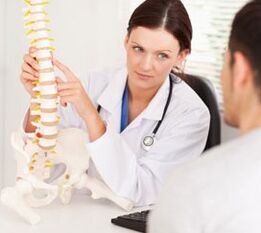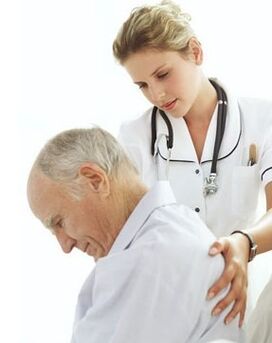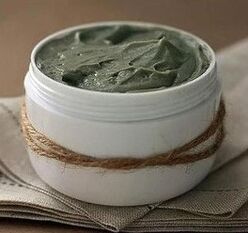Osteochondrosis-The disease of the spine, whose characteristic is the degenerative-distribution lesion of intervertebral discs and then the vertebral tissues themselves.
The main sign of osteochondrosis is neck or back pain. Among other symptoms, muscle atrophy, impaired sensitivity, disorders in the work of internal organs are distinguished. Depending on the location of the pathological process, cervical, chest and lumbar osteochondrosis is distinguished. If this disease and its treatment do not pay the necessary attention, the process of damage to the spine will be irreversible.

In English literature, the term "osteochondrosis" means this group of diseases of the musculoskeletal system, such as osteocondropathy.
The main factor, or the cause that leads to the development of osteochondrosis, is an unequal distribution of the load in the spine, which occurs when using in one hand or shoulder of weights (for example, bags, backpack), a long stay in a position sitting in the wrong pose, night remains in a mattress or pill. Additional factors can also be a sedentary lifestyle, obesity, injuries and flat feet.
All the above situations over the years lead to frequent pain in the cervical spine, chest or sacral spine.
According to statistics, osteochondrosis occurs from 40 to 90% of the world population, especially between 30 and 35 years. Under adverse conditions, this disease develops in adolescence, which usually contributes to the use of a severe uncomfortable backpack, especially on a shoulder, uncomfortable shoes and injuries.
The development of osteochondrosis
The development of osteochondrosis occurs in 4 selected stages (degree):
1st stage osteochondrosis.It is characterized by the beginning of the pathological process in the intervertebral disc polypoozom nucleus - its dehydration (dehydration) occurs and, later, the height of the disk decreases. At the same time, cracks begin to appear in the fibrous ring. At this stage, the patient usually feels no change. The discomfort can manifest with an unusual position for an active person or exercise.
Osteochondrosis 2 stages.With a decrease in the height of the discs, the distance between the neighboring vertebrae also decreases and the vertebrates and ligaments begin to give in a little. This process leads to the ultimateness of two neighboring vertebrae, which can lead to its slip and/or displacement. Spondylolistz is formed. Due to displaced vertebrae, the patient in a certain load seems a real discomfort and sometimes pain in the field of pathology.
Osteochondrosis 3 stages.It is characterized by the formation of prolassos and records of discs, sometimes there are subluxation and arthrosis in the intervertebral joints. The patient may feel rigid in some movements, feel tingling in the limbs, sometimes numbness appears. In the third degree of osteochondrosis, back pain, neck and coccyx area, depending on the location of the disease, is already present.

Osteochondrosis 4 stages.The body is trying to correct the excessive mobility of the vertebrae, as well as normalize the operation of the spine. At the vertebrae connection site with pathology, bone neoplasms grow in each - osteophytes, which, when forming in a unnecessary place, can cause microtrauma to a nerve spine and sometimes a neighboring vertebra. In discs and joints, fibrous ankylosis processes can begin. The motor segment is covered with vegetation and becomes as it has stopped. At the same time, the main signs of osteochondrosis are minimized and sometimes generally not noticeable.
Osteochondrosis symptoms
The main symptoms of osteochondrosis are discomfort and back pain or neck. The strength of pain and other related signs of this disease depend on the degree of osteochondrosis.
Obviously, due to intervertebral disc pathology, their hernias grow in vertebrae (osteophytes), there are a large number of disturbances such as circulatory disorders, pinching nerves, irritation and violations in normal spinal cord, edema and even fibrosis of bercenaries. All of these disorders can cause a wide clinical image of the disease and be expressed by an abundant amount of different symptoms; Therefore, without a complete diagnosis of osteochondrosis, it is very difficult to make the correct diagnosis and prescribe proper treatment.
However, we will consider the main symptoms of osteochondrosis:
- back pain, cervical region, lumbar, shoulders and even ribs;
- discomfort, rigidity of the back with some movements, raising something;
- dormancy of the limbs (arms and/or legs);
- the feeling of pain in the arms and legs, chills;
- muscle cramps;
- disorders in the work of the genitals;
- headaches, dizziness;
- heart pain;
- impaired sensitivity;
- muscle hypotension;
- Increased fatigue, sometimes the eye.
In addition, depending on the area of the spine where osteochondrosis reached, the following symptoms are distinguished:
Cervical spine osteochondrosis.Hand pain and shoulders prevail, headache, dizziness, "flies" or spots in front of the eyes, noise on the head. These signs may also indicate the presence of vertebral artery syndrome, which can also complicate the work of the cardiac muscle and myocardial blood vessels if other diseases are present in them.
Thoracic spine osteochondrosis.Chest pain, heart areas and breathing discomfort prevail.
Osteochondrosis of the lumbosacra spine.Pain in the lower back prevails, giving the legs or pelvic organs. Violation of sexual function.

Osteochondrosis complications
If osteochondrosis is not treated and placed at a pace, this can lead to the development of the following diseases and pathologies:
- a hernia of the intervertebral disc (spine hernia);
- protrusion;
- kyphosis;
- radiculitis;
- deposit in the space between the vertebrae of the salts;
- spinal cord blow;
- lose weight of members and their atrophy;
- Palsy of the legs.
The causes of osteochondrosis
- Mechanical back trauma (spine);
- Physical body overtension, hard work;
- nervous exhaustion, stress;
- Violation of metabolism, poisoning;
- Frequent stay in places with increased vibration;
- Hereditary predisposition;
- sedentary lifestyle, sedentary work;
- Violation of posture at an early age;
- overweight, obesity;
- Smooth feet;
- Wearing uncomfortable shoes (tight, jumps);
- Night vacation in an uncomfortable bed - a mattress, a pillow;
- frequent dehydration;
- lower nutrition, hypovitaminosis;
- Smoking;
- pregnancy.
Osteochondrosis classification
The classification of osteochondrosis is very different, because the disease itself was not fully studied.
We highlight the most popular ways to separate this disease.
Osteochondrosis is distinguished. . .
By location:
- The cervical department ©
- Thoracic region (th or d)
- Lumbar (L)
- The Sacral Department (s)
Osteochondrosis diagnosis
The diagnosis of osteochondrosis includes the following exam methods:
- anamnesis;
- Examination X -Ray (X -Ray);
- myelography;
- Neurological examination.
In addition, they can name:
- Computed tomography (CT);
- Nuclear Magnetic Resonance (JAMR);
- Magnetic resonance tomography (magnetic resonance imaging).
Treatment of osteochondrosis
Treatment of osteochondrosis implies the use of a set of measures that should be performed for a very long period of time (from 1 to 3 months + about 1 year for rehabilitation), to which many patients react very ambiguously. Therefore, it should be noted that, indirectly, the assistant doctor's recommendations, the prediction for the patient's recovery is minimal.

An additional problem in the treatment of osteochondrosis usually becomes self -medication. The fact is that, as already written in the article, with this disease, the clinical picture is quite ambiguous and broad. The patient without diagnosis begins to select medications against what hurts and, eliminating pain, deals with his daily life, while the disease continues to progress.
The treatment of osteochondrosis is performed by two main methods: conservative and surgical treatment. In addition, there are general recommendations in the treatment of osteochondrosis, such as a diet, rehabilitation.
Conservative treatment of osteochondrosis
Conservative treatment of osteochondrosis aims to interrupt pain syndrome, normalization of the spine and its components, as well as the prevention of additional dystrophic changes in a person's "axis".
Conservative treatment of osteochondrosis includes:
Drug therapy.It is used to relieve pain and inflammation of the components of the spine of the tissues, as well as the normalization of metabolic processes.
To stop pain and inflammation processes, several therapeutic blocks are also used. In addition, they contribute to a decrease in muscle-Tonic syndrome. Among the therapeutic blockade, there are: trigger points block, as well as intra-oss, paravertebral and epidural block.
Physiotherapy.It is used to relieve pain, increasing the effectiveness of drug therapy and in the rehabilitation period. Treatment is performed using ultrasound, laser, magnetic fields, low frequency chains, etc.
Medical Physical Education (Exercise Therapy), Cinerapia.Especially selected dosed exercises, designed to correct muscle corset, strengthening, posture correction, normalization of muscle tissue and its flexibility, decompression of nerve roots, preventing possible complications of the disease. All of this is achieved due to the normalization of intervertebral disc metabolism and nutrition, blood circulation, restoration of distance from discs and vertebrae, load distribution throughout the musculoskeletal system.
Massage.It is used to improve blood circulation, relieve the rigidity and tension of muscle tissue, improve the general condition of health.
Whirlpool.Contributes to the normalization of blood circulation, metabolism, an increase in the tone of muscle tone and the normalization of the nervous system. This implies body massage with the help of a flow of water with a certain pressure directed at it. It is true that the whirlpool prevails recently using air bubbles supplied to the body in specially equipped baths or pools.
Manual therapy.It is used according to an individually selected program, affecting the bone muscle system insightful. It helps improve blood circulation and lymphatic cycle, metabolism, musculoskeletal system mobility, strengthen the immune system and prevent possible complications.
(Traction) extension of the spine.It is used using special equipment to increase intervertebral space, the correction of the spine structure, which usually leads to minimize or completely relieve pain.
Integrated use of the above treatment for osteochondrosis has a good effect.
Osteochondrosis diet
With osteochondrosis, it is necessary to eat 6 times a day, in small portions, drinking at least 1, 5 liters of water daily.
What can be consumed with osteochondrosis:Dairy products, low meat varieties (chicken, meat), jelly, flooded fish, gelatin, fresh vegetables (tomatoes, cucumber, onion, carrots, beets, pepper, cabbage, celery, broccoli, avocado, nuts, seeds of sunflower, spinofacho, machars), fruits, avocado, avocado, avocado, avocadoNuts, seeds of Sunflower, Spinache, Mouraras), fruits, avocado.
What needs to be minimized in osteochondrosis foods:Grapes, vegetables (peas, beans, etc. ), flour products, spicy spices, sugar, salty foods, meat broths and smoked meats.
It is better to cook food, because with this preparation method, the products maintain the maximum amount of vitamins and tracking elements.

Try to season salads with olive oil.
Surgical treatment of osteochondrosis
Surgical treatment of osteochondrosis is used if the conservative method is ineffective. Prescribed by the assistant doctor. It can also be used for severe spinal injuries and its components.
Treatment of osteochondrosis with folk remedies
Folk remedies against osteochondrosis
Mass.Prepare a small mass of rye flour, 300 grams and let it lie at room temperature for a few days. Drink a glass of milk and rub the place where your back hurts with one you will wait. After curling the dough in gauze and attach it to the painful point, tie a cellophane over and then a scarf or towel. After a while, you may feel burning and tingling in this area, but tolerate how much you can. Do the procedure every day. Use every batch of pasta no more than 3 times.
Saber.Make a dye of knowledgefish. The place where the back hurts, with the tincture prepared with the tincture prepared and tie -a with a scarf. Also, you can get some dye from knowing a few drops before bed.
Osteochondrosis ointment.Add 1 tablespoon to the container. One spoon of flour, 1 egg, 100 g butter and 1 tablespoon. A spoonful of vinegar, mix okay and put a dark place for 2 days to insist. After excluding the foam resulting from the mixture. Once again, mix the mixture well and rub the ointment resulting in a painful point.
Radish.Mix 300 ml of radish juice, 200 g of honey and 100 ml of vodka. Rub your back with the resulting mixture. This popular remedy also helps with radiculitis and rheumatism.



































